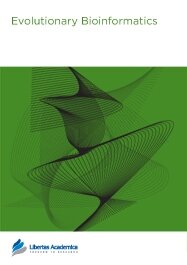

Publication Date: 25 Jun 2012
Type: Original Research
Journal: Evolutionary Bioinformatics
Citation: Evolutionary Bioinformatics 2012:8 357-371
doi: 10.4137/EBO.S9017

In phylogenetic analyses of nucleotide sequences, ‘homogeneous’ substitution models, which assume the stationarity of base composition across a tree, are widely used, albeit individual sequences may bear distinctive base frequencies. In the worst-case scenario, a homogeneous model-based analysis can yield an artifactual union of two distantly related sequences that achieved similar base frequencies in parallel. Such potential difficulty can be countered by two approaches, ‘RY-coding’ and ‘non-homogeneous’ models. The former approach converts four bases into purine and pyrimidine to normalize base frequencies across a tree, while the heterogeneity in base frequency is explicitly incorporated in the latter approach. The two approaches have been applied to real-world sequence data; however, their basic properties have not been fully examined by pioneering simulation studies. Here, we assessed the performances of the maximum-likelihood analyses incorporating RY-coding and a non-homogeneous model (RY-coding and non-homogeneous analyses) on simulated data with parallel convergence to similar base composition. Both RY-coding and non-homogeneous analyses showed superior performances compared with homogeneous model-based analyses. Curiously, the performance of RY-coding analysis appeared to be significantly affected by a setting of the substitution process for sequence simulation relative to that of non-homogeneous analysis. The performance of a non-homogeneous analysis was also validated by analyzing a real-world sequence data set with significant base heterogeneity.
PDF (1.03 MB PDF FORMAT)
RIS citation (ENDNOTE, REFERENCE MANAGER, PROCITE, REFWORKS)
BibTex citation (BIBDESK, LATEX)
XML
PMC HTML
This is the fastest progress we have experienced from submission to acceptance. Reviews are fast, pertinent, and instructive. Every step of the process is visible and prompt, and every email is friendly and immediate. In all, it is an excellent experience to be published in Libertas Academica.

All authors are surveyed after their articles are published. Authors are asked to rate their experience in a variety of areas, and their responses help us to monitor our performance. Presented here are their responses in some key areas. No 'poor' or 'very poor' responses were received; these are represented in the 'other' category.See Our Results
Copyright © 2013 Libertas Academica Ltd (except open access articles and accompanying metadata and supplementary files.)
Facebook Google+ Twitter
Pinterest Tumblr YouTube